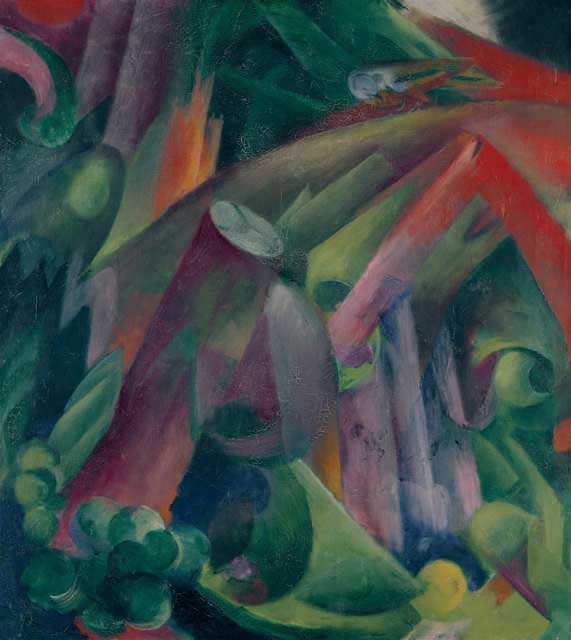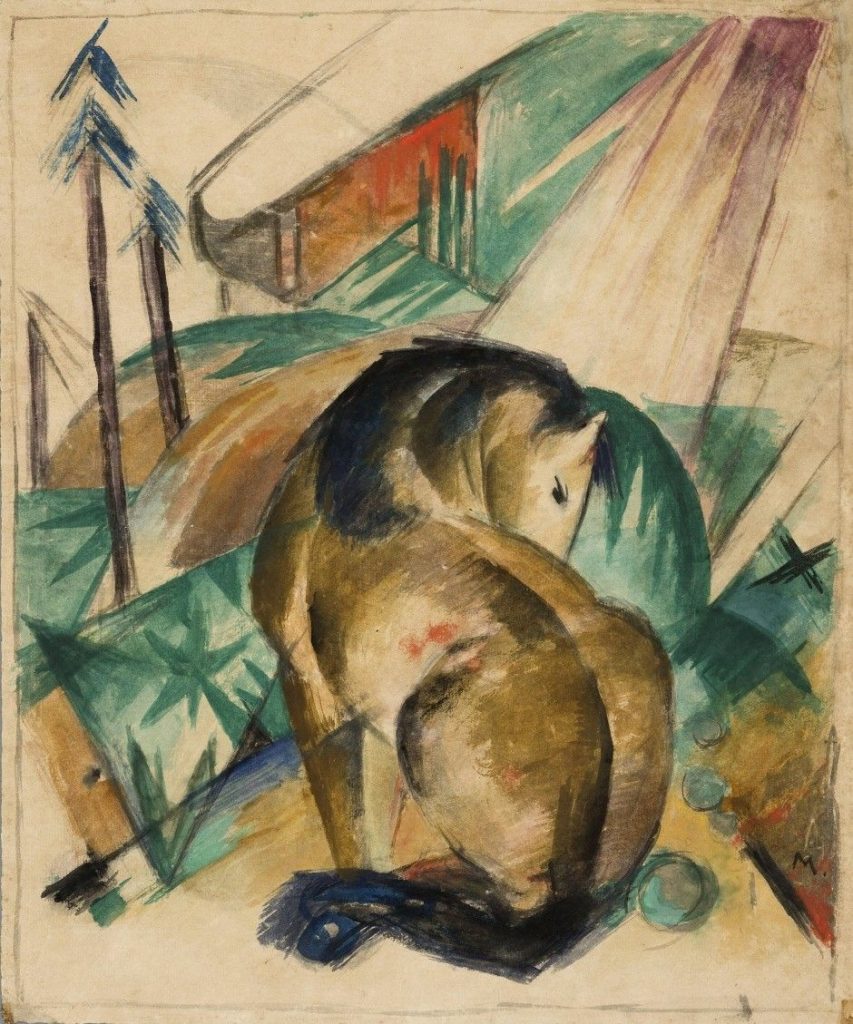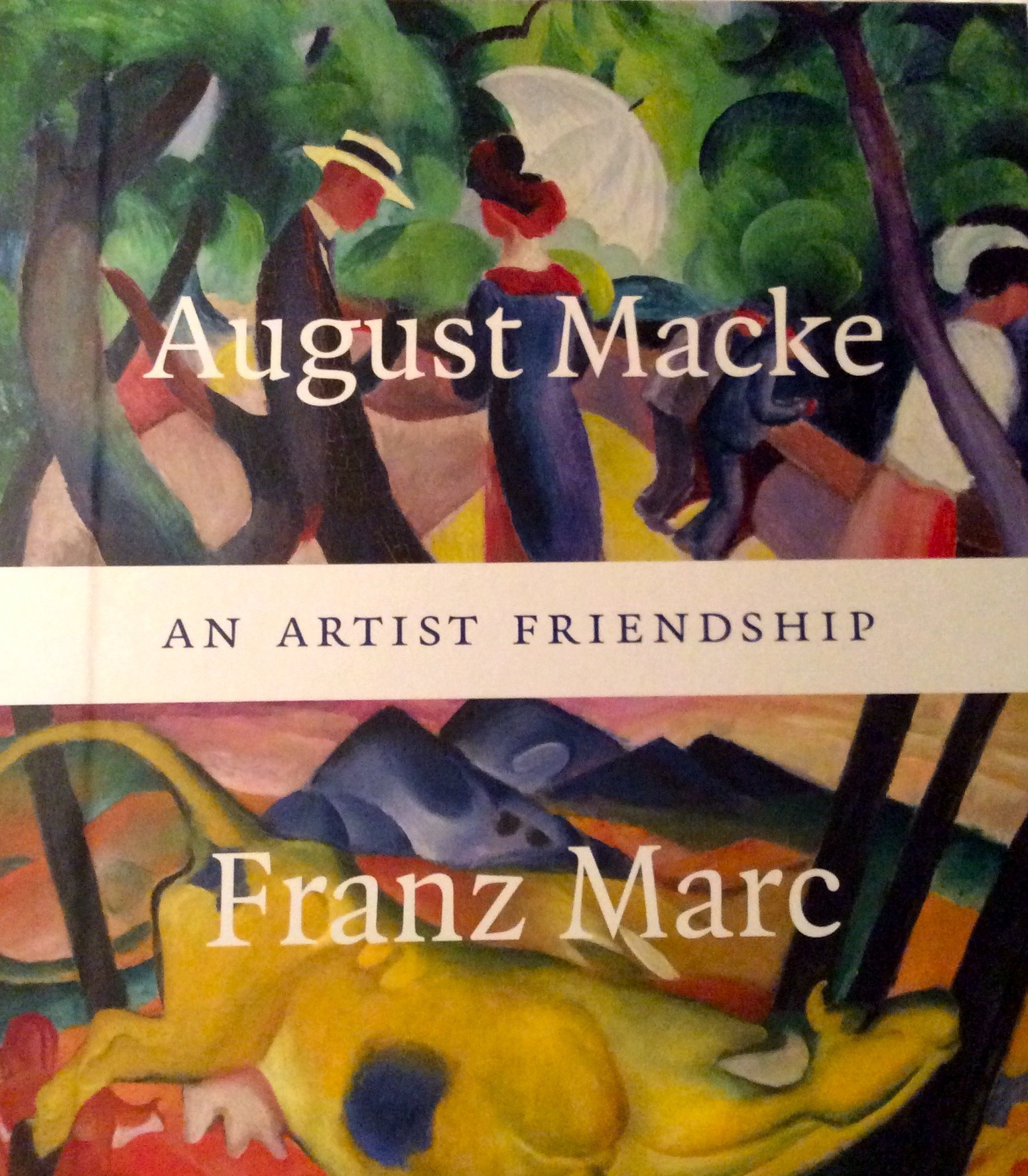
by Jean Marie Carey | 20 Apr 2018 | Animals in Art, Art History, Franz Marc, German Expressionism / Modernism, Re-Enactments© and MashUps

Franz Marc, Waldinneres mit Vogel (Taube), 1912.
Following below my reviews of two catalogues relating to the Hildebrand–Cornelius–Gurlitt bequeathal (artworks from the Gurlitt hoard) as has appeared on the Museum Books website and archived on Humanities Commons. First some digressions on the subject of Raubkunst.
One of the works recovered in Munich in 2012 you see here, Franz Marc’s Waldinneres mit Vogel (Taube) (1912). As in Die Vögel (also 1912 – I am just saying!) which lives at the Lenbachhaus, it is very hard to reproduce and thus to see the tone and hue of the violet Marc uses in these paintings about the avian experience. More on this soon, but hopefully you can get a bit of an idea of just how luminous and concatenate the purple and jades are in this canvas. Doubtful it can undergo conservation.

Franz Marc, Waldinneres mit Vogel (Taube), 1912, detail.
Both of these catalogues are very good, and I’m sure the forthcoming second part of the Gurlitt Status Report will be excellent too. (In another of the case’s amusing-macabre turns, these volumes are issued by the Hirmer Verlag, Hirmer, you may recall being the menswear hoarding store of choice of Cornelius Gurlitt. The companies are unrelated.)
But one of the things a scholarly work, at least under the present rules of publication, cannot capture is the intense emotion the discovery of the Gurlitt trove aroused in those who love the work – and not just art historians. One of the most intense experiences I had in Munich was the day in 2013 the Gurlitt seizure was revealed in FOCUS magazine. When the Süddeutsche Zeitung and Frankfurter Allgemeine began flashing notifications and tweets about the story at around 15:00 on 3 November, Schwabing’s ride-or-die Expressionism lovers (i.e. everyone in the neighborhood) literally ran out onto the streets both to steal a “just out walking” glimpse of the Gurlitt flat on the north side and to snatch up physical copies of FOCUS. I was fortunate to be on the U3 on the way to Schleißheimerstr already and just jumped off at the Olympiapark stop and, for once observing Bavarian queue rules, jostled my way up to the front of the news seller’s and grabbed the last one.
When I heard Simon Goodman speak at the Getty Research Institute this past March I was struck of course by his story, which is told in his book The Orpheus Clock: The Search for My Family’s Art Treasures Stolen by the Nazis (2015), but also by his marshaling of those powerful narrative and emotional resources that come from outside academic art historical presentation. You can view the whole talk at the Getty website.

Franz Marc, Waldinneres mit Vogel (Taube), 1912, detail.
First and foremost is the title: Who wouldn’t want to read a book called The Orpheus Clock, no matter what it was about? Goodman never wavers from the issue of provenance research that is in the foreground of the saga – if you watch the video you will hear Thomas W. Gaehtgens recount how Goodman quietly and unassumingly worked in the Getty library for years without revealing himself – but the story of the family, and the intrinsic value of the stolen and then recovered artwork, moves the narrative.
The other thing that strikes me, as my own Raubkunst at the Ringling project inches forward, is the cost of this kind of research, in every sense. For all his drive, patience, eloquence, and charm, Simon Goodman had a few advantages in his quest. But finally even the well-educated polyglot with many financial security, business, legal, and social connections could only use the threat of raining shame upon Sotheby’s and Christie’s to move them to reveal important information about the eponymous 16th Century silver and paintings by Cranach, Degas. Drive and weaponized publicity should not be the only avenues of retributive justice available. Systemic cooperation needs to lead.

Franz Marc, Sitzendes Pferd, c. 1912.
Look at this multimedia extravaganza! LOOK AT IT! LöL. Don’t ever tell me again FM isn’t funny.
The Gurlitt Hoard
In the wake of the revealed discovery in November 2013 of what has become known as the “Gurlitt hoard” – the thousands of artworks seized in a 2012 raid by the by German Federal, Bavarian State, and Munich police upon the Schwabing apartment of then 80-year-old Cornelius Gurlitt – a number of thoughtful and well-researched books have emerged, notably The Munich Art Hoard: Hitler’s Dealer and His Secret Legacy (2015) by Catherine Hickley.[1] Gurlitt, the peripatetic son of art dealer, gallerist, and sometime-curator Hildebrand Gurlitt, died in May 2014, bequeathing his collection to the Kunstmuseum Bern. The lifting of the embargo by a German court to allow Gurlitt’s trove to be dispensed to the museum was far from acclaimed – in fact, with many of the Gurlitt hoard works by 20th Century luminaries missing since the 1930s recovered from Gurlitt’s possession-jammed flat still of uncertain provenance – quite the opposite. Thus the museum of the city of Bern has been placed on defensive alert even while surely exulting over the acquisition of paintings, drawings, and prints by Franz Marc, August Macke, Henri Matisse, Ernst Ludwig Kirchner, and many others that greatly enrich our understanding of the historical avant-garde.
A Gurlitt hoard research catalogue and attendant exhibition was promised by the Kunstmuseum Bern, surveying the contents of its permanent collection as well for the presence of Raubkunst. And director Matthias Frehner kept his promise. The depth if not the scope of Modern Masters “Degenerate” Art at the Kunstmuseum Basel, the resulting publication, is even more ambitious than anticipated. lt offers a comprehensively illustrated checklist of the paintings from the Gurlitt acquisition as well as many other fascinating images and tales, from an account of the activities of patron-donor Othbar Huber to archival photographs rarely seen of Kathe Thannhauser and Herwarth Walden. However the excellent series of volumes Gurlitt Status Report: – Confiscated and Sold, Kunstmuseum Bern – Nazi Art Theft and Its Consequences, Art and Exhibition Hall of the Federal Republic of Germany (the second has just appeared – watch this space for updates) taking stock both more specifically and in consideration of the broader ramifications of the Gurlitt situation to some extent eclipses the Bern effort, launched from a collaborative co-exhibition at the Bundeskunsthalle Bonn.
(more…)

by Jean Marie Carey | 21 Jul 2017 | Art History, Franz Marc, German Expressionism / Modernism, LÖL, Re-Enactments© and MashUps
Much as I enjoy burying the lede, the headline on this story is that I found a heretofore unpublished photo, and this is the Franz Marc photo, taken in the spring of 1914 by the artist’s brother, Paul Marc, in Munich:

Franz Marc, 1914, in Munich. Photo by Paul Marc. Germanisches Nationalmuseum | Des Deutschen Kunstarchivs | Nürnberg
The whole story of finding the Franz Marc photo and a thorough analysis of why it might be that significant images of people and animals are overlooked is forthcoming in the second part of the “Exposing Animals” sequence of Antennae: The Journal of Nature in Visual Culture in September, and this photograph and some others will be reproduced there, but it is also appearing in a different kind of work I did for Empty Mirror Books that comes out this week, so I decided to post it, finally (I first found it in 2015!), here today.
Beyond standing as a strong reminder that there is so much we have not yet learned about the historical avant-garde, this is just a wonderful photograph, “eerie and magnificent,” as Marc would say, so I will just leave it at that for now.

by Jean Marie Carey | 20 Jan 2017 | Art History, August Macke, Expressionismus, Franz Marc, German Expressionism / Modernism, Helmuth Macke
Book Review: August Macke and Franz Marc: An Artist Friendship
Catalog of an exhibition held at the Kunstmuseum Bonn, 25 September 2014 – 4 January 2015; and at the Städtische Galerie im Lenbachhaus und Kunstbau, Munich, 28 January – 3 May 2015; 359 pages with many color illustrations and black and white archival photographs.
I recently began doing some book reviews for Museum Bookstore, an online repository of catalogues and other printed material generated on behalf of museum and gallery exhibitions. My first review is of my favorite book of 2014-2015, the outstanding catalogue presented by the Lenbachhaus and Kunstmuseum Bonn in support of August Macke und Franz Marc: eine Künstlerfreundschaft. Please support this very worthy independent bookstore effort by checking out the companion text on the site.
§ § §
Published on 26 September 1914 to coincide with the 100th anniversary of the death of August Macke as well as the launch of the ambitious cooperative retrospective of Macke’s and Franz Marc’s overlapping oeuvres, the exhibition catalogue August Macke and Franz Marc: An Artist Friendship (August Macke und Franz Marc: eine Künstlerfreundschaft is its twin in the original German from which the English version has been translated) is, perhaps not surprisingly, a tour-de-force of editing and research. What is unexpected is that the editors, longtime Lenbachhaus Blaue Reiter curator Annegret Hoberg and Volker Adolphs of Kunstmuseum Bonn, along with a smartly-assembled team of university- and museum-based German art historians, bring to bear not just a wealth of knowledge but so much compassion to these essays, confronting directly the loss and sadness we naturally feel over the too-short lives of Marc and Macke. Macke, the extroverted Rhinelander, was killed in Champagne, France, at 27, while Marc, the contemplative Bavarian, died aged 36 at Verdun in the spring of 1916.
 Despite their frank sentimentality, the catalogue’s chapters and essays are impeccably scholarly. Hoberg’s “August Macke and Franz Marc / Ideas for a Renewal of Painting” and Adolphs’ “Seeing the World and Seeing Through the World / Nature in the Work of August Macke and Franz Marc” are classic art historiography based in peerless analysis. Hoberg focuses on the milieu of the international avant-garde that encouraged Marc and Macke to not only follow the careers of but become personally acquainted with the Parisian Orphist Robert Delaunay and the Italian Futurist Umberto Boccioni. While Marc’s primary subjects directly encompass animals and the pastoral, albeit reframed through a unique pantheistic realism, Macke, who often painted urban scenes, has a less direct relationship to “nature,” which Adolphs teases out, particularly in comparison to Marc.
Despite their frank sentimentality, the catalogue’s chapters and essays are impeccably scholarly. Hoberg’s “August Macke and Franz Marc / Ideas for a Renewal of Painting” and Adolphs’ “Seeing the World and Seeing Through the World / Nature in the Work of August Macke and Franz Marc” are classic art historiography based in peerless analysis. Hoberg focuses on the milieu of the international avant-garde that encouraged Marc and Macke to not only follow the careers of but become personally acquainted with the Parisian Orphist Robert Delaunay and the Italian Futurist Umberto Boccioni. While Marc’s primary subjects directly encompass animals and the pastoral, albeit reframed through a unique pantheistic realism, Macke, who often painted urban scenes, has a less direct relationship to “nature,” which Adolphs teases out, particularly in comparison to Marc.
(more…)

by Jean Marie Carey | 28 Jul 2016 | Animals, Animals in Art, Art History, Franz Marc

Franz Marc’s mysterious nude in a landscape from around 1911.
In clear contrast to the well-planned execution of the grazing horses on its front, the verso of Weidende Pferde IV is wild, mysterious, and haunting, and provides an intimate look at Franz Marc’s more intuitive approach to color and form.
Though the composition is partially obscured, the underlying motifs are clear enough.
Shown is a reclining female nude in a dimly lighted landscape under a deep blue sky. The figure rests on her back, her right leg is bent. Her head with long and flowing red hair is slightly tilted to the right; her arms clasped behind her. This figure is somewhat characteristic for Marc in terms of the visible hatching and decorated, colorful outlines. The left of the picture area seems to indicate another figure whose gender and position we can only guess at. The middle of the picture consists of a dramatic, deeply-hued landscape, which in turn is what the reclining nude in the foreground would be part of and also looking at. Though Marc often painted nude figures relaxing outside, this painting does not seem to correspond to another finished work.

Weidende Pferde IV, 1911
Weidende Pferde IV is also a stunning picture when considered in terms of Marc’s efforts to produce it: Three red horses with purple mane prance against a lemon-yellow sky and a deep blue rock formation. Marc had devoted a lot of time to developing the arrangement of the horses’ bodies in this formation. Marc had been preoccupied, and had made a difficult and lengthy process of, how exactly to balance the shapes and colors of the horses in the overall composition.
Weidende Pferde IV is the star of the second part of the exhibition trilogy “Franz Marc: Zwischen Utopie und Apokalypse,” presented by the Franz Marc Museum in Kochel on the 100th anniversary of the death year of the painter. This is one of just a few paintings that Marc saw hung in a museum himself, following its creation in 1911 and first display at the Thannhauser’s Galerie Moderne in Munich
The same year the collector Karl Ernst Osthaus purchased Weidende Pferde IV for the Folkwang Museum’s first incarnation in Hagen. The painting sold for 750 marks, as Marc triumphantly informed his brother Paul on 3 December 1911.
Marc had been constantly busy with live horses during his years in Kochel and Sindelsdorf (“Pferde auf Bergeshöh gegen die Luft stehend”), and he studied them in detail as he drew, printed and painted them.
-

-
Franz Marc, c. 1909
-

-
Franz Marc, c. 1910
-

-
Franz Marc, c. 1910
The day before Alexej Jawlensky, Marianne von Werefkin and Adolf Erbslöh first visited Marc in Sindelsdorf on 3 February 1911, he wrote to Maria Marc who had at this time had left Bavaria to stay with her parents in Berlin, “Ich habe noch ein großes Bild mit 3 Pferden in der Landschaft, ganz farbig von einer Ecke zur anderen, angefangen, die Pferde im Dreieck aufgestellt. Die Farben sind schwer zu beschreiben. Im Terrain reiner Zinnober neben reinem Kadmium und Kobaltblau, tiefem Grün und Karminrot, die Pferde gelbbraun bis violett.”
The visitors loved the paintings, and by the day of his 31st birthday on 8 February Marc was a co-chairman of Neue Künstlervereinigung München.
Certainly the powerful painting of the reclining redhead should be regarded as an entirely discrete creation and given a proper name and place in the artist’s catalogue raisonné. It is curious that Harvard University’s Busch-Reisinger Museum, which purchased the painting when it was declared Entartete Kunst in 1937, has not taken the initiative to see that this is done. If only this painting could be permanently repatriated to Kochel, where it belongs.

by Jean Marie Carey | 16 Mar 2016 | Animals in Art, Art History, August Macke, Dogs!, Expressionismus, Franz Marc, German Expressionism / Modernism
 Indexical photo with authorial shadow; graves of Franz and Maria Marc
Indexical photo with authorial shadow; graves of Franz and Maria Marc
On 4 March 2016, the 100th anniversary of the death of the painter, animal lover, writer, and ever-elusive person Franz Marc, I visited Marc’s grave in Kochel. Initially I had intended to spend the day between the Lenbachhaus and the Pinakothek der Moderne in München immersed in the paintings I have studied now for many years. But in truth I am devoted to Marc’s life as much as his art, and it seemed more right to take make a pilgrimage and pay respects in the proper sense of the word in the tiny Bavarian town where Marc lived off and on.
This trip was covered on the now-silent Franz Marc Twitter account and received much support and nice wishes from many kind souls.
It was a very emotional experience and had some typical Bavarian humorous adventures as well. I arrived on the regional train at about 11:00 on a dazzling clear, cold day, with most of the snow from the previous week’s blizzard still on the ground. The Ammergau Alps, what Marc called „das blaues Land“, glowed. Inserting itself into this majestic, somber first act was the fact that, in Kochel, Ruhezeit on Fridays apparently begins at 11:00…and this was a very intense Ruhezeit too…everything had abruptly closed, including the flower shop where I had intended to get some violets. I should add that all the flowers and plants were just sitting there outside, and the doors to the shop were open, but the lights were off and the people away being quiet. This was the same at other shops – I have always found it very amusing that in places where Ruhezeit is taken seriously, lunch places also close, even though Ruhezeit is at lunch time, and Kochel takes Ruhezeit quite seriously. In fact it was Friday Ruhezeit the entire time I was there. I stayed until 16:00, the hour of Marc’s death.
(more…)












